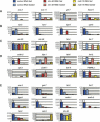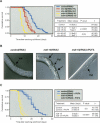A Mediator subunit, MDT-15, integrates regulation of fatty acid metabolism by NHR-49-dependent and -independent pathways in C. elegans
- PMID: 16651656
- PMCID: PMC1472473
- DOI: 10.1101/gad.1395406
A Mediator subunit, MDT-15, integrates regulation of fatty acid metabolism by NHR-49-dependent and -independent pathways in C. elegans
Abstract
The Caenorhabditis elegans Nuclear Hormone Receptor NHR-49 coordinates expression of fatty acid (FA) metabolic genes during periods of feeding and in response to fasting. Here we report the identification of MDT-15, a subunit of the C. elegans Mediator complex, as an NHR-49-interacting protein and transcriptional coactivator. Knockdown of mdt-15 by RNA interference (RNAi) prevented fasting-induced mRNA accumulation of NHR-49 targets in vivo, and fasting-independent expression of other NHR-49 target genes, including two FA-Delta9-desaturases (fat-5, fat-7). Interestingly, mdt-15 RNAi affected additional FA-metabolism genes (including the third FA-Delta9-desaturase, fat-6) that are regulated independently of NHR-49, suggesting that distinct unidentified regulatory factors also recruit MDT-15 to selectively modulate metabolic gene expression. The deregulation of FA-Delta9-desaturases by knockdown of mdt-15 correlated with dramatically decreased levels of unsaturated FAs and multiple deleterious phenotypes (short life span, sterility, uncoordinated locomotion, and morphological defects). Importantly, dietary addition of specific polyunsaturated FAs partially suppressed these pleiotropic phenotypes. Thus, failure to properly govern FA-Delta9-desaturation contributed to decreased nematode viability. Our findings imply that a single subunit of the Mediator complex, MDT-15, integrates the activities of several distinct regulatory factors to coordinate metabolic and hormonal regulation of FA metabolism.
Figures






Similar articles
-
The Mediator complex of Caenorhabditis elegans: insights into the developmental and physiological roles of a conserved transcriptional coregulator.Nucleic Acids Res. 2015 Feb 27;43(4):2442-53. doi: 10.1093/nar/gkv037. Epub 2015 Jan 29. Nucleic Acids Res. 2015. PMID: 25634893 Free PMC article. Review.
-
Coordinate regulation of lipid metabolism by novel nuclear receptor partnerships.PLoS Genet. 2012;8(4):e1002645. doi: 10.1371/journal.pgen.1002645. Epub 2012 Apr 12. PLoS Genet. 2012. PMID: 22511885 Free PMC article.
-
NHR-49/HNF4 integrates regulation of fatty acid metabolism with a protective transcriptional response to oxidative stress and fasting.Aging Cell. 2018 Jun;17(3):e12743. doi: 10.1111/acel.12743. Epub 2018 Mar 5. Aging Cell. 2018. PMID: 29508513 Free PMC article.
-
A Caenorhabditis elegans nutrient response system partially dependent on nuclear receptor NHR-49.Proc Natl Acad Sci U S A. 2005 Sep 20;102(38):13496-501. doi: 10.1073/pnas.0506234102. Epub 2005 Sep 12. Proc Natl Acad Sci U S A. 2005. PMID: 16157872 Free PMC article.
-
Control of Caenorhabditis elegans life history by nuclear receptor signal transduction.Exp Gerontol. 2006 Oct;41(10):904-9. doi: 10.1016/j.exger.2006.06.062. Epub 2006 Sep 11. Exp Gerontol. 2006. PMID: 16963217 Review.
Cited by
-
The Mediator complex of Caenorhabditis elegans: insights into the developmental and physiological roles of a conserved transcriptional coregulator.Nucleic Acids Res. 2015 Feb 27;43(4):2442-53. doi: 10.1093/nar/gkv037. Epub 2015 Jan 29. Nucleic Acids Res. 2015. PMID: 25634893 Free PMC article. Review.
-
Cardiac-Secreted Factors as Peripheral Metabolic Regulators and Potential Disease Biomarkers.J Am Heart Assoc. 2016 May 31;5(6):e003101. doi: 10.1161/JAHA.115.003101. J Am Heart Assoc. 2016. PMID: 27247337 Free PMC article. Review. No abstract available.
-
Mechanisms of Mediator complex action in transcriptional activation.Cell Mol Life Sci. 2013 Aug;70(15):2743-56. doi: 10.1007/s00018-013-1265-9. Epub 2013 Jan 30. Cell Mol Life Sci. 2013. PMID: 23361037 Free PMC article. Review.
-
Immunity-linked genes are stimulated by a membrane stress pathway linked to Golgi function and the ARF-1 GTPase.Sci Adv. 2023 Dec 8;9(49):eadi5545. doi: 10.1126/sciadv.adi5545. Epub 2023 Dec 6. Sci Adv. 2023. PMID: 38055815 Free PMC article.
-
Mediator Subunit Med15 Regulates Cell Morphology and Mating in Candida lusitaniae.J Fungi (Basel). 2023 Mar 8;9(3):333. doi: 10.3390/jof9030333. J Fungi (Basel). 2023. PMID: 36983501 Free PMC article.
References
-
- Ashrafi K., Chang F.Y., Watts J.L., Fraser A.G., Kamath R.S., Ahringer J., Ruvkun G. Genome-wide RNAi analysis of Caenorhabditis elegans fat regulatory genes. Nature. 2003;421:268–272. - PubMed
-
- Asturias F.J., Jiang Y.W., Myers L.C., Gustafsson C.M., Kornberg R.D. Conserved structures of mediator and RNA polymerase II holoenzyme. Science. 1999;283:985–987. - PubMed
-
- Blazek E., Mittler G., Meisterernst M. The mediator of RNA polymerase II. Chromosoma. 2005;113:399–408. - PubMed
-
- Bourbon H.M., Aguilera A., Ansari A.Z., Asturias F.J., Berk A.J., Bjorklund S., Blackwell T.K., Borggrefe T., Carey M., Carlson M., et al. A unified nomenclature for protein subunits of mediator complexes linking transcriptional regulators to RNA polymerase II. Mol. Cell. 2004;14:553–557. - PubMed
-
- Bryant G.O., Ptashne M. Independent recruitment in vivo by Gal4 of two complexes required for transcription. Mol. Cell. 2003;11:1301–1309. - PubMed
Publication types
MeSH terms
Substances
Grants and funding
LinkOut - more resources
Full Text Sources
Other Literature Sources
Molecular Biology Databases
Research Materials
Miscellaneous
